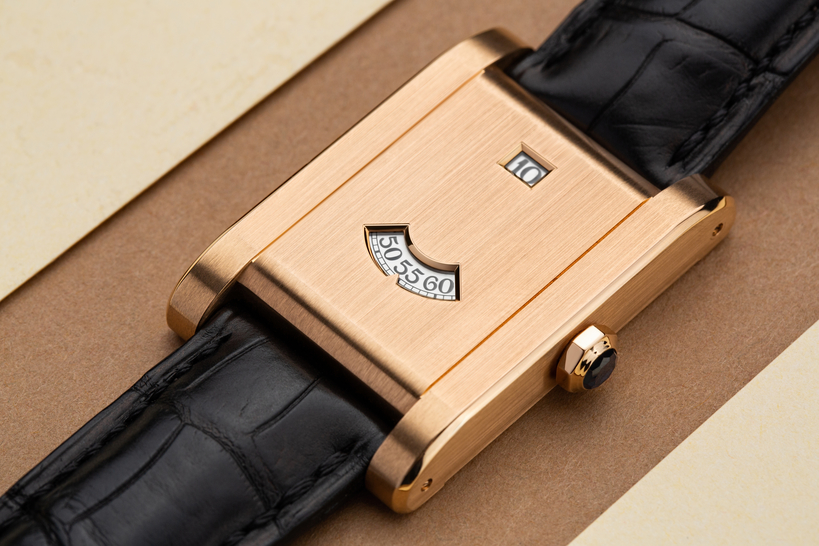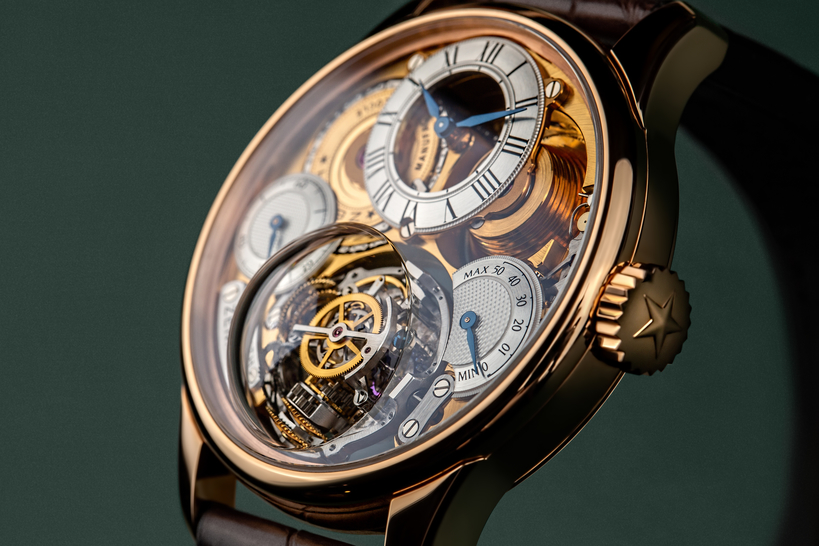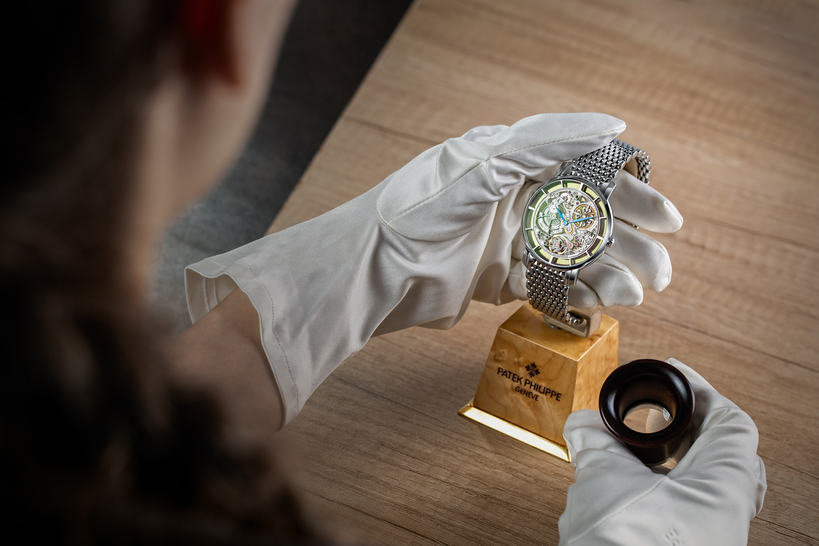Thie fourth and final part on the subject of thin watches touches the chronographs and minute repeaters.
The humble chronograph is normally viewed as a practical complicated function and is typically downplayed in marketing compared to other classic complicated devices such as the tourbillon, the perpetual calendar and repeaters. However, these watches deserve more credit for their complexity in terms how they're constructed and set. This is especially true of classic movements with a lateral (horizontal) clutch and functions activated by a column wheel.
The fact that chronographs are underappreciated has led to a lack of almost any appetite among watch brands to invest in developing chronographs, and that includes thin chronographs. They're justifiably apprehensive that their clients won't give them the appreciation they deserve, and will see the watches as overpriced, which will result in a low level of sales.
The first company to begin designing thin chronographs was Blancpain, which unveiled the hand-wound Caliber 1180 in 1987 with a column wheel and vertical clutch manufactured by Frédéric Piguet. Less than four millimeters thick at just 3.95 mm, it was the world's thinnest chronograph wristwatch movement at the time.
An automatic winding system was added to Caliber 1180, which resulted in the movement expanding to 5.5 mm, and with these measurements, the new automatic Caliber 1185 became the thinnest automatic chronograph.
Another modification made with the addition of a split-seconds module to Caliber 1180 allowed Blancpain to add another record to the watchmaker’s list in 1988: a hand-wound split-second chronograph movement called Caliber 1181, which was 5.35 mm thick.
A split-seconds chronograph with a new record-thin movement was unveiled by Patek Philippe in 2005 — the manual winding Patek Philippe caliber CHR 27-525 PS with a lateral clutch and two column wheels — which was 5.25 mm thick.
Only 10 years later was Vacheron Constantin able to trump this measurement by 0.5 mm, when the company released the Harmony Ultra-Thin Grande Complication Chronograph Caliber 3500 in 2015, a wristwatch which housed the self-winding ultra-thin Caliber 3500 with a peripheral rotor. The movement was 5.2 mm thick inside its 8.4 mm watch case.
The extraordinary master of thin watch movements Jaeger-LeCoultre didn't regret joining the race to create record-breaking thin chronograph caliber. The company presented the simply remarkable Reverso Chronographe watch in 1996, the first chronograph wristwatch in a reversible case known as the Reverso.
As a brand specializing in thin watches and watch movements, Piaget didn't want to fall behind. In 2007, the watchmakers at Piaget introduced Caliber 880P, a thin automatic flyback chronograph movement with a column wheel and a vertical coupling clutch. The movement was 5.6 mm thick (N.B. back in 2007, Piaget called this movement the 800P).
This watch is especially noteworthy for its hand-wound Caliber 829 movement with a column wheel and vertical clutch, which was kept to an incredibly thin 4.5 mm. At the end of 2014, the brand announced the development of a modified version of this movement, the hand-wound Caliber 883P. By removing the automatic winding mechanism and slimming down a number of components, the watchmaker managed to reduce the total thickness of the movement to 4.65 mm.
At the end of 2014, the Piaget announced hand-wound Caliber 883P wich total thickness equaled to 4.65 mm
Based on this movement, the company announced the debut of the thinnest wristwatch chronograph at the time, the Altiplano Chronograph with a 8.24 mm case. The most significant progress in making thinner chronograph wristwatches and movements was made by Bvlgari.
In 2019, the company presented the self-winding Octo Finissimo Chronograph GMT Automatic with a horizontal clutch, functions activated by a column wheel, and a peripheral winding rotor for its automatic winding. The watch's Caliber BVL 318 movement is 3.30 mm thick, housed inside the 6.90 mm case.
In 2020, the Bvlgari Octo Finissimo Tourbillon Chronograph Automatic reached a new achievement for models with both a tourbillon and a chronograph: the watch's Caliber BVL 388 movement was 3.50 mm thick, enclosed in a 7.40 mm case.
The development of thin minute repeater wristwatches followed a different trajectory. The reason for this was that in the late 19th century and early 20th century there was a tangible demand for compact watch movements to be fit into ladies' pocket watches and pendent watches.
That's why there were already minute repeater movements on the market at that stage which were perfectly suitable for wristwatches, and the earliest minute repeater wristwatches were equipped with these very movements.
In 1941-1942, the Swiss manufacturer Vacheron Constantin and the Dubois-Dépraz movement factory was already designing extremely thin manual winding minute repeater movements specifically for wristwatches: the 3.1 mm Caliber 13’’’JMV.
It was a long time before anyone attempted to beat this result, and it wasn't until 1981 when the Swiss watchmaker and movement manufacturer Pierre Michel Golay designed an even slimmer ultra-thin hand-wound minute repeater for the firm Gérald Genta, which was 2.72 mm thick, allowing the brand to produce 7 mm watch cases.
In 1985, he was the one who also developed a modification with automatic winding and a center rotor, which resulted in the movement expanding to 4.5 mm. In the 2000s, the first watchmaker to set himself the challenge of creating thin minute repeaters was François-Paul Journe based in Geneva, who founded the brand F. P. Journe.
Even though the manual winding Caliber 1408 he designed was a long way off record measurements, it still made the ultra-thin category at 4.9 mm. One has to admit that the Répétition Souveraine watch this movement housed was remarkably thin at 8.65 mm.
In 2013, Piaget unveiled its own version of an automatic minute repeater movement with a micro-rotor. The Emperador Coussin Ultra-Thin Minute Repeater watch made to encase the Caliber 1290P was 9.4 mm thick, and the movement itself was 4.8 mm thick. Jaeger-LeCoultre managed to pare down this measurement by a tenth of a millimeter in 2014.
The Caliber 362 movement the company designed with a minute repeater, tourbillon and an automatic winding system with a peripheral rotor was 4.7 mm thick, and enclosed in the 7.8 mm Master Ultra-Thin Minute Repeater Flying Tourbillon watch case (also known as the Hybris Mechanica 11).
Caliber 1408 designed by the brand F. P. Journe had a thickness at 4.9 mm
What makes this achievement all the more impressive is that a tourbillon has been built into the movement, and the Caliber 362 is the undisputed champion in the category of minute repeaters with tourbillons.
In 2013, Vacheron Constantin finished developing a thin manually wound minute repeater. At 3.9 mm thick, the Caliber 1731 movement housed in the Patrimony Minute Repeater Ultra-Thin watch didn't overstep the psychologically important 4 mm threshold, and the watch case was 8.19 mm thick.
The company in the lead for now is Bvlgari, since the Caliber BVL 362 was unveiled in 2016. This movement is a modified version of the one Pierre Michel Golay created for the brand Gérald Genta, which was acquired by Bvlgari in 2000. Caliber BVL 362 is currently the thinnest minute repeater movement on the market at 3.12 mm thick, and its Octo Finissimo Minute Repeater watch case is 6.85 mm thick.



